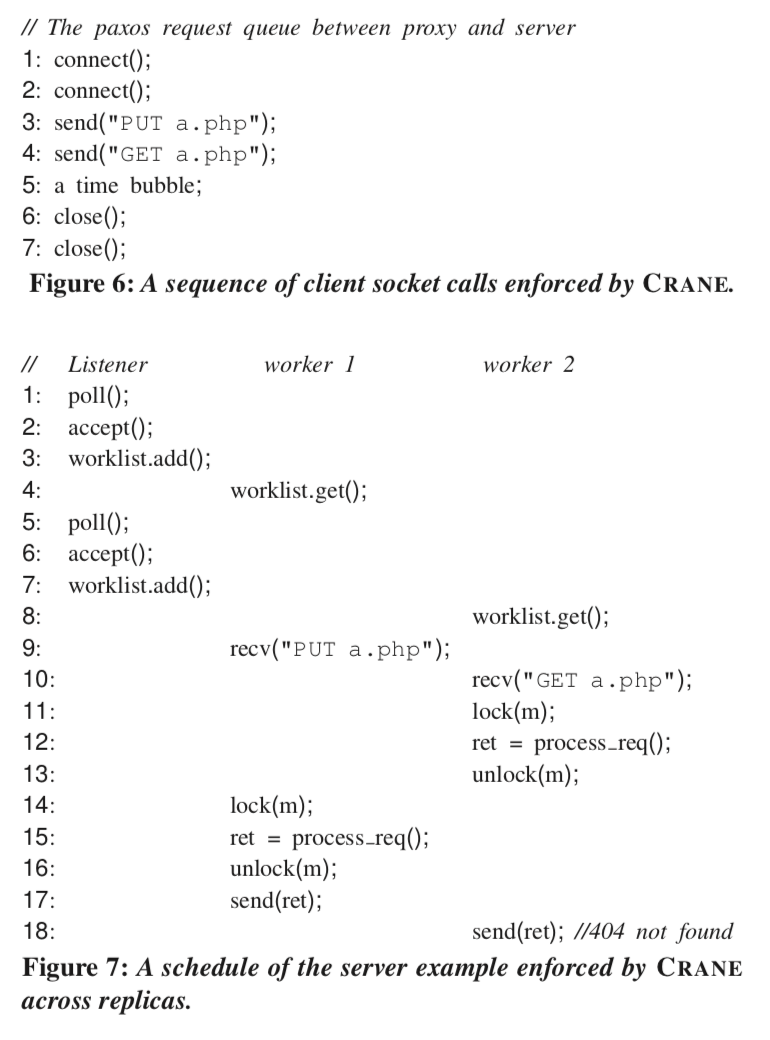
Cui, Gu, Liu, Chen and Yang
Paxos Made Transparent: What we will cover
- Introduction and problem description
- State Machine Replication and Paxos
- Deterministic Multithreading and PARROT
- Time-bubbling and CRANE
- Implementating CRANE
- Evaluating CRANE
- Conclusion and Class Discussion
Introduction and Problem Description
In a network we have a situation as portrayed below. Several clients making requests from a server:
A happy network is one where the server is available.
This means that replication to handle faults that may occur is a desirable feature. So let's replicate everything a server does in a simple, consistent, practical, and reliable way!

understand and implement Paxos.
Also to make it work more generally, combine it with a deterministic scheduler that can reliably handle many threads coming in asynchronously.
Oh, and of course, pick a cool bird acronym!
Paxos is an island off the west coast of Greece. Leslie Lamport imagined an ancient parliamentary system:
“ Recent archaeological discoveries on the island of Paxos reveal that the parliament functioned despite the peripatetic propensity of its part-time legislators. The legislators maintained consistent copies of the parliamentary record, despite their frequent forays from the chamber and the forgetfulness of their messengers.
- State Machine $\Rightarrow$ consists of a set of states, a set of transitions between states, and a current state. Transition to a new state happens after an operation is issued. The new state can be the same state, modeling a read only operation.
- If this machine can no longer transition states, then it has crashed. But in an asynchronous environment, we can't tell if a machine is slow or it has crashed.
- It masks failures, like crashes.
- Surely we want to replicate deterministic machines, so same input + same program = same output.
- For example, a DNS server.
Yes!
..ish..

A practical runtime for deterministic, stable and reliable threads.
- It reduces the number of schedules for all inputs.
- It allows for programmer added "hints" to prioritize computations.
- It will ignore determinism for performance critical sections.


Hi I'm a client! S'up, client here. Me too. Don't forget me, I'm a client.
...and we are out of sync...
For example: two clients make simultaneous HTTP PUT and GET requests for the same page.
Different arrival times lead to different outcomes!
Enter time-bubbling!

Two parameters for this technique:
- $W_{timeout}$: "the physical duration that the primary's DMT scheduler waits before it request consensus on a time bubble insertion."
- $N_{clock}$: "the number of logical clocks within each time bubble."
Correctly ReplicAting Nondeterministic Executions
Yay! They did it!

- Uses CRIU (open-source tool) to checkpoint registers and memory.
- Uses LXC (Linux containers - like Docker) to checkpoint file system state.
diff -ruN httpd-2.2.11/modules/generators/mod_cgid.c httpd-2.2.11-modified/modules/generators/mod_cgid.c
--- httpd-2.2.11/modules/generators/mod_cgid.c 2015-06-23 19:11:58.484786127 +0800
+++ httpd-2.2.11-modified/modules/generators/mod_cgid.c 2015-06-23 19:12:56.676785084 +0800
@@ -564,8 +564,10 @@
ap_log_error(APLOG_MARK, APLOG_ERR, err, r->server, "%s", description);
}
+#include
static int cgid_server(void *data)
{
+ tern_disable_sched_paxos();
struct sockaddr_un unix_addr;
int sd, sd2, rc;
mode_t omask;
github.com/columbia/crane
Evaluation
-
They tested CRANE using a set of 3 replicas:
- Linux 3.13.0, 1Gbps bandwidth LAN
- 2.80 GHz dual-socket hex-core Intel Xeon with 24 hyperthreading cores
- 64GB memory, and 1TB SSD
-
On 5 widely used server programs:
Apache Mongoose MediaTomb ClamAV MySQL




Discussion
- CRANE can be summarized as "PARROT (stable deterministic multithreading) with PAXOS" - why is both stability and determinism important?
- What are some limitations of the CRANE and/or PARROT systems?
- CRANE performance depends on adding PARROT "performance hints" to indicate "these are the major computations to line up." The authors emphasize the brevity of these hints - what would you suggest to also make it easier to diagnose and correctly insert them?
- What suggestions for enhancement or further work would you make for the CRANE system (with a primary goal of encouraging adoption and broad utility)?